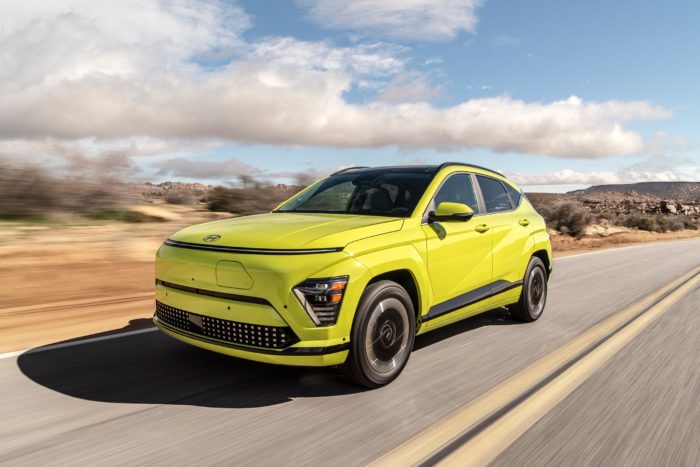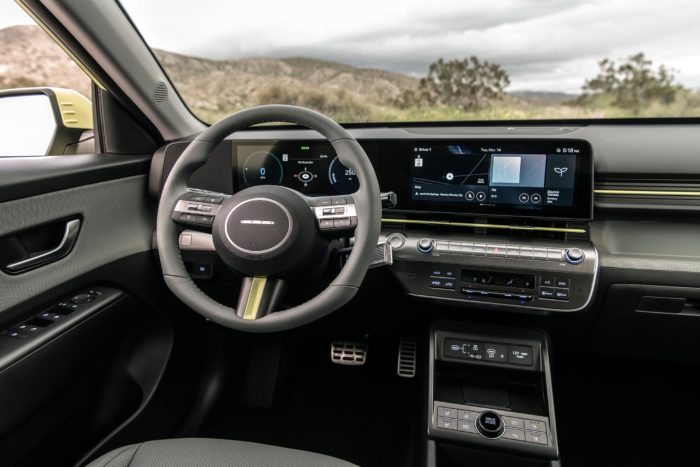Weeks after rolling out a version of the 2024 Kona for the Korean home market, Hyundai pulled the wraps off the U.S. crossover during a news conference at the New York International Auto Show.
For American buyers, there will be a variety of different options, including both standard and long-range battery packs for the Kona Electric, and two different drivetrains for gas models. There’ll also be a more sporty-looking Kona N Line.
“The all-new Kona and Kona Electric continue to build upon our extremely successful first-generation model, with outstanding efficiency, innovative technologies, distinctive styling, and comprehensive safety features,” said José Muñoz, president and CEO, Hyundai Motor North America.
Hyundai Kona Gets Longer & Wider in 2024

One of the first things a shopper likely will notice is that the little crossover has grown a lot bigger. Overall length is up by as much as 7 inches, depending upon the version of the crossover. The wheelbase has been stretched by 2.3 inches, and the 2024 Kona is about an inch wider than the outgoing model.
Another selling point, cargo space increases to 25.5 cubic feet with the rear seatbacks up and 63.7 cubic feet with them folded down.

Unlike Hyundai’s electric-only Ioniq 5 and 7 other EVs, Kona uses a platform that has to adapt to a variety of different drivetrain options. In what Hyundai describes as “an unconventional” approach, its product development team started out by working up the second-generation Kona Electric.
The challenge was to optimize the placement of its battery pack, motor, and power electronics to avoid cutting into passenger and cargo space while still leaving flexibility for the placement of two internal combustion engine options.
2024 Kona Gets 2 Battery-Pack Options

The battery drive relies on a single electric motor powering the front wheels. The base Kona Electric features a 48.6kWh lithium-ion battery that offers an EPA-estimated 197 miles of range. It makes a modest 133 horsepower.
The optional, 64.8kWh long-range pack takes that up to 260 miles. And it jumps to 201 horsepower. But torque is the same for both engines, at 188 pound-feet. Curiously, that’s a sharp drop from the outgoing Kona which could muster as much as 291 pound-feet.

The bigger pack can be charged up using 120- or 240-volt systems, or plugged into a quick charger cutting the time needed to go from a 10-80% state-of-charge down to 43 minutes.
Kona owners can tap into both of the crossover’s lithium-ion packs, if needed, to provide power at, say, a camp or worksite, or to power home appliances in the event of a brown or blackout.
2024 Hyundai Kona: 2 Gas Engine Options
There are two gas-powered options, meanwhile, starting with the base 2.0L four-cylinder Atkinson cycle engine makes 147 horsepower and 132 pound-feet of torque. It’s paired with a continuously variable transmission (CVT).

The upgrade on the N Line and Limited is a 1.6L turbocharged-four bumping power up to 190 horsepower and 195 pound-feet. It’s mated to an eight-speed automatic gearbox.
Unlike the front-drive-only Kona Electric, gas models are available in both front- or all-wheel-drive configurations.
The most obvious visual difference with the 2024 Hyundai Kona is its added mass. The Electric and gas-powered Limited models measure just over 171 inches, with the N Line further stretched to 172.6. The wheelbase on all models has stretched to 104.7 inches.
2024 Kona Styling Changes

Other tweaks are modest for a second-generation model. There is, for example, a lightbar running atop the new grille, which is framed by lower-mounted headlamps.

The Kona N Line doesn’t get any more power but does adopt some sporty touches, including body color cladding, a two-tip exhaust, and a new, two-piece rear spoiler. Inside, the N Line adds red accents, sport seats up front, and aluminum sport pedals.

All versions get upgrades to materials and finishes. The Kona Electric comes standard with what Hyundai describes as a “floating horizontal C-Pad with integrated, dual 12.3-inch panoramic display screens.” There’s an expanded range of advanced driver assistance systems, as well.
Hyundai doesn’t plan to release pricing until closer to the on-sale date during the third quarter of 2023.
